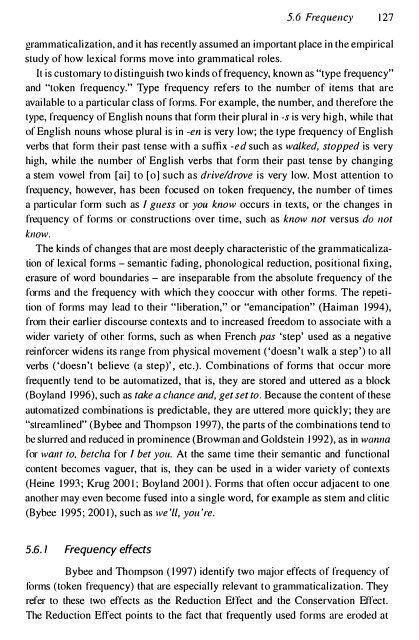Gram - SEAS
Gram - SEAS
Gram - SEAS
You also want an ePaper? Increase the reach of your titles
YUMPU automatically turns print PDFs into web optimized ePapers that Google loves.
5.6 Frequency 127<br />
grammaticalization, and it has recently assumed an important place in the empirical<br />
study of how lexical forms move into grammatical roles.<br />
It is customary to distinguish two kinds ot"frequency, known as "type frequency"<br />
and "token frequency." Type frequency refers to the number of items that are<br />
available to a particular class of forms. For example, the number, and therefore the<br />
type, frequency of English nouns that form their plural in -s is very high, while that<br />
of English nouns whose plural is in -en is very low; the type frequency of English<br />
verbs that form their past tense with a suffix -ed such as walked. stopped is very<br />
high, while the number of English verbs that form their past tense by changing<br />
a stem vowel from [ail to [0] such as drive/drove is very low. Most attention to<br />
frequency, however, has been focused on token frequency, the number of times<br />
a particular form such as I guess or you know occurs in texts, or the changes in<br />
frequency of forms or constructions over time, such as know not versus do not<br />
kllow.<br />
The kinds of changes that are most deeply characteristic of the grammaticalization<br />
of lexical forms - semantic fading, phonological reduction, positional fixing,<br />
erasure of word boundaries - are inseparable from the absolute frequency of the<br />
forms and the frequency with which they cooccur with other forms. The repetition<br />
of forms may lead to their "liberation," or "emancipation" (Haiman 1994),<br />
from their earlier discourse contexts and to increased tj·eedom to associate with a<br />
wider variety of other forms, such as when French pas 'step' used as a negative<br />
reinforcer widens its range from physical movement ('doesn't walk a step') to all<br />
verbs ('doesn't believe (a step)" etc.). Combinations of forms that occur more<br />
frequently tend to be automatized, that is, they are stored and uttered as a block<br />
(Boyland 1996), such as take a chance and, get set to. Because the content of these<br />
automatized combinations is predictable, they are uttered more quickly; they are<br />
"streamlined" (Bybee and Thompson 1997), the parts of the combinations tend to<br />
be slurred and reduced in prominence (Browman and Goldstein 1992), as in wanna<br />
for wa'" to. betcha for I bet you. At the same time their semantic and fu nctional<br />
content becomes vaguer, that is, they can be used in a wider variety of contexts<br />
(Heine 1993; Krug 200 I ; Boyland 200 I ). Forms that often occur adjacent to one<br />
another may even become fused into a single word, for example as stem and c1itic<br />
(Bybee 1995; 2001), such as we 'll, you 're.<br />
5.6. 1 Frequency effects<br />
Bybee and Thompson (1997) identify two major effects of frequency of<br />
forms (token frequency) that are especially relevant to grammaticalization. They<br />
refer to these two effects as the Reduction Etfect and the Conservation Effect.<br />
The Reduction Effect points to the fact that frequently used forms are eroded at
















